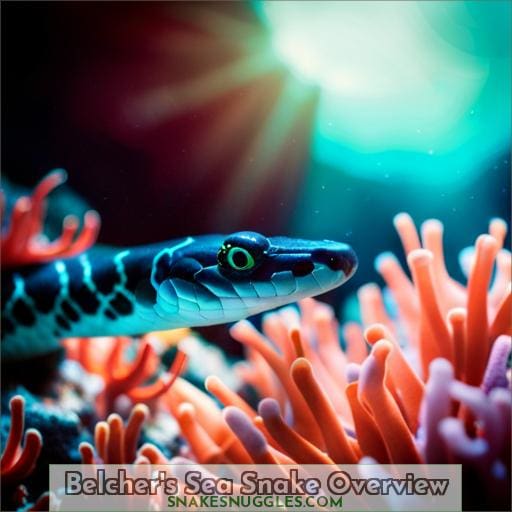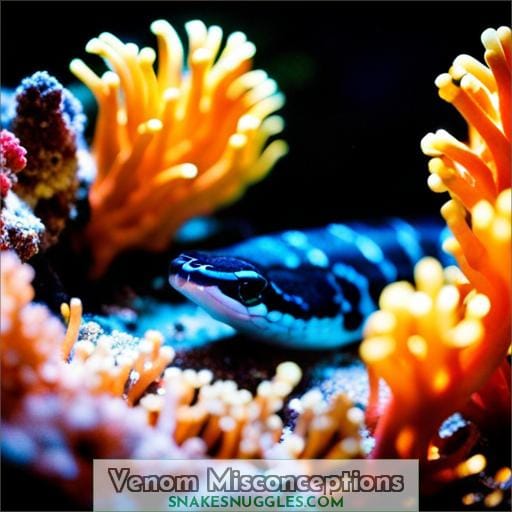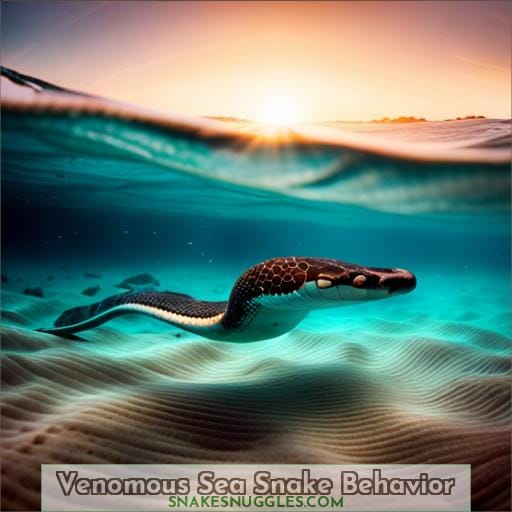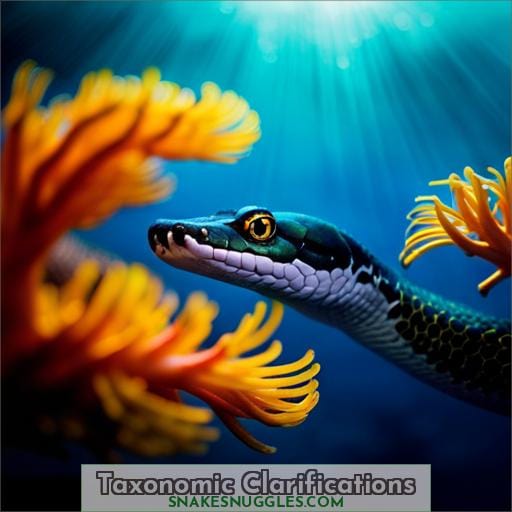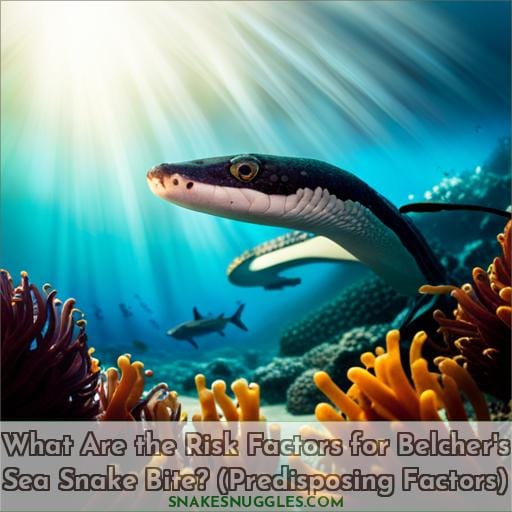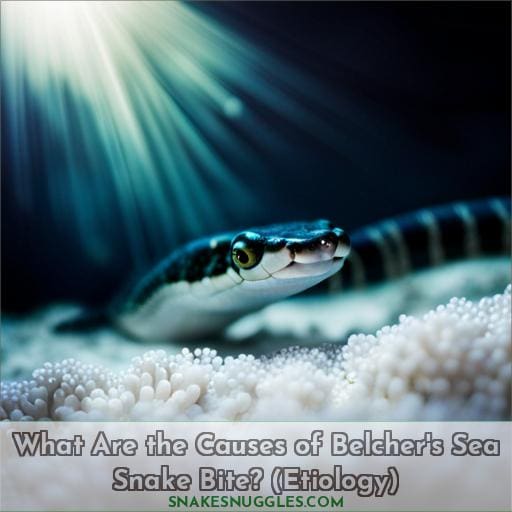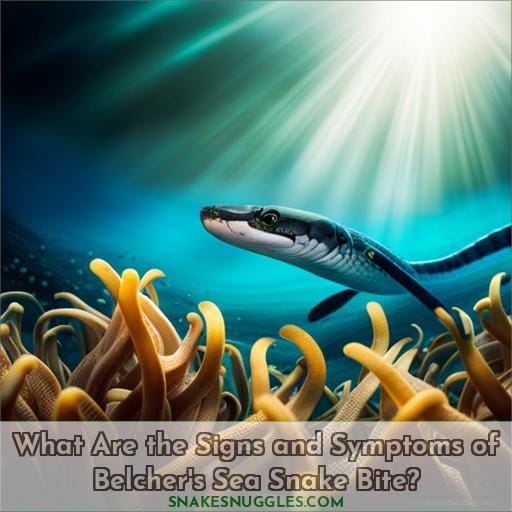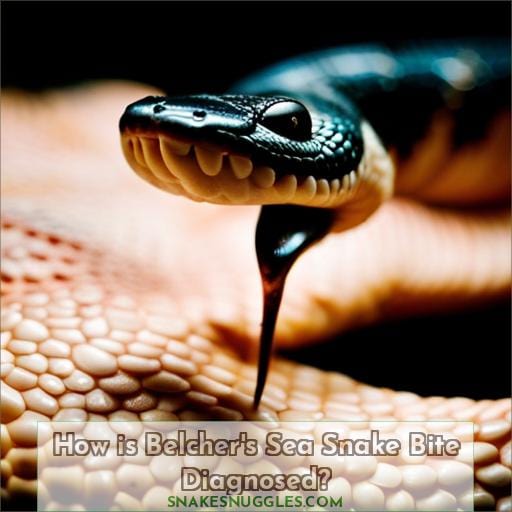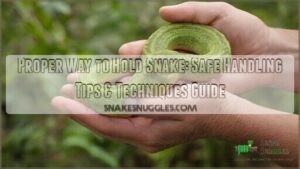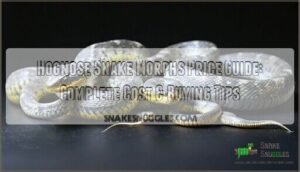This site is supported by our readers. We may earn a commission, at no cost to you, if you purchase through links.
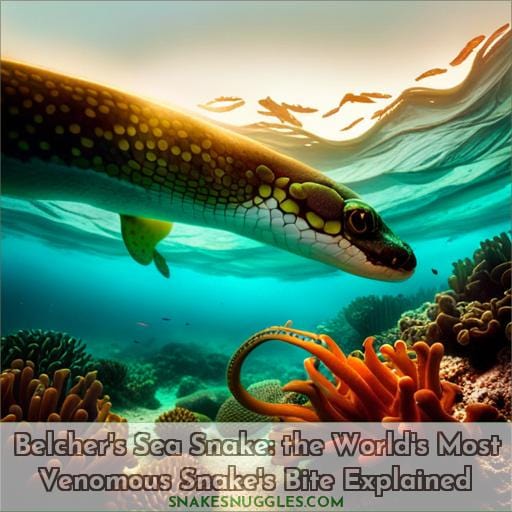 Imagine encountering the world’s most venomous snake, Belcher’s Sea Snake. Curious about its bite and venom? Look no further. In this article, you’ll find an in-depth explanation of the effects and characteristics of a Belcher’s Sea Snake bite.
Imagine encountering the world’s most venomous snake, Belcher’s Sea Snake. Curious about its bite and venom? Look no further. In this article, you’ll find an in-depth explanation of the effects and characteristics of a Belcher’s Sea Snake bite.
Gain valuable insights into misconceptions surrounding their venom and learn about risk factors associated with these encounters. Prepare yourself with knowledge as we explore the causes, signs, symptoms, and diagnosis of this fascinating yet dangerous encounter with nature’s formidable predator: Belcher’s Sea Snake Bite Explained.
Table Of Contents
- Key Takeaways
- Belcher’s Sea Snake Overview
- Venom Misconceptions
- Animal Name Origin
- Venomous Sea Snake Behavior
- Taxonomic Clarifications
- Who Gets Belcher’s Sea Snake Bite? (Age and Sex Distribution)
- What Are the Risk Factors for Belcher’s Sea Snake Bite? (Predisposing Factors)
- What Are the Causes of Belcher’s Sea Snake Bite? (Etiology)
- What Are the Signs and Symptoms of Belcher’s Sea Snake Bite?
- How is Belcher’s Sea Snake Bite Diagnosed?
- Frequently Asked Questions (FAQs)
- What first aid should be administered for a Belcher’s sea snake bite?
- What antivenom is used to treat Belcher’s sea snake bites?
- What is the geographic distribution and migration patterns of Belcher’s sea snake?
- How can Belcher’s sea snake bites be prevented in endemic regions?
- What are some common myths and misconceptions about Belcher’s sea snakes?
- Conclusion
Key Takeaways
- Highly venomous elapid sea snake
- About 25% of bites result in life-threatening envenomation
- Venom misconceptions due to testing errors and bite frequency
- Taxonomy and accurate evaluation are essential for understanding venom potency
Belcher’s Sea Snake Overview
Belcher’s Sea Snake is a highly venomous elapid sea snake, known for its timid temperament and rare tendency to bite unless mistreated. D믭 the world’s most venomous snake, its actual venom potency has been misconstrued.
Herpetologist Bryan Grieg Fry corrected myths pertaining to Belcher’s sea snake and its taxonomic confusion with the hook-nosed sea snake.
Despite potent venom, only about 25% of Belcher’s sea snake bites result in life-threatening envenomation. Victims may experience misleading initial symptoms, masking the progressive danger. Seeking urgent medical care is vital, as severe untreated bites can rapidly cause flaccid paralysis, respiratory failure, and death within hours due to muscle breakdown.
Although the prognosis is generally good with prompt, appropriate antivenom treatment, prevention through avoidance remains key regarding these snakes.
Venom Misconceptions
Why’s Belcher’s sea snake mistakenly portrayed as the world’s most venomous snake?
You’re often told its toxicity surpasses even the inland taipan’s, but testing errors led to these misconceptions, which herpetologist Bryan Grieg Fry has since corrected.
The belief that Belcher’s sea snake is the most venomous arises from misleading narratives and incorrect venomous rankings.
While it’s true that this species possesses a highly potent neurotoxic venom, recent insights from Fry have clarified that its LD50 value (the lethal dose required to kill 50% of test subjects) in mice doesn’t exceed the inland taipan’s.
Other factors such as bite frequency and envenomation rates also contribute to determining a snake’s overall danger level.
Therefore, scientific taxonomy and accurate evaluation are crucial in understanding the true nature of different snakes’ venoms compared to each other for improved sea snake handling practices and effective prevention strategies against their bites.
Animal Name Origin
You’re probably wondering why it’s called Belcher’s sea snake when you come across the faint-banded serpent. Well, let me clarify that for you. The name Belcher actually honors Royal Navy Captain Admiral Sir Edward Belcher, who was an explorer in the mid-1800s and led expeditions to survey various parts of the world.
During one of his voyages, he encountered this venomous sea snake and it was named after him as a tribute to his contributions in marine exploration.
Here are some interesting insights regarding the animal name origin:
- Hydrophis: The genus name Hydrophis is derived from Greek roots meaning water serpent, reflecting its aquatic nature.
- Specific Name: belcheri refers to Captain Edward Belcher.
- Common Misnaming: This species is often misidentified as the hook-nosed sea snake (Enhydrina schistosa) or blue-banded sea snake (Hydrophis cyanocinctus), causing confusion among researchers and enthusiasts.
- Taxonomy Clarified by Bryan Fry: Dr. Bryan Grieg Fry has played a significant role in clarifying misconceptions surrounding venomous snakes through his research on their taxonomy and venoms.
So now you know how this fascinating creature got its distinctive name!
Venomous Sea Snake Behavior
When encountering a venomous sea snake, it’s important to understand its behavior and tendencies in order to avoid potential bites.
Belcher’s sea snakes display a timid temperament, rarely biting people unless severely mistreated or mishandled.
Most venomous encounters and bites occur among fishermen that handle fishing nets.
Despite having potent venom, only about one quarter of Belcher’s sea snake bites result in actual envenomation and injection of toxins.
This is due to the snake’s small fangs and preference to flee rather than attack threats.
Overall, the faint-banded sea snake tends to be shy and reluctant to bite unless subjected to extreme aggravation or unintentional contact.
Caution is still advised to prevent fatal envenomations from occurring, even though bites are infrequent from these timid snakes.
Taxonomic Clarifications
To clarify the taxonomic confusion surrounding Belcher’s sea snake, let’s delve into its scientific name and distinguish it from other similarly named species.
The scientific name of this highly venomous sea snake is Hydrophis belcheri. It’s often mistakenly confused with the hook-nosed sea snake (Enhydrina schistosa) and incorrectly called the blue-banded sea snake (Hydrophis cyanocinctus).
However, it should be noted that Dubois’ seasnake holds the title of most venomous sea snake, debunking the myth that Belcher’s sea snake is indeed the world’s most venomous species.
Despite these taxonomic clarifications, there are still limited knowledge about specific behavioral patterns and effects of their potent venoms due to minimal research conducted on them. Further studies and accurate identification are essential for understanding these elusive creatures better and ensuring our safety in their presence.
Who Gets Belcher’s Sea Snake Bite? (Age and Sex Distribution)
If you venture into coastal regions where Belcher’s sea snakes are endemic, you may be at risk of getting bitten by these highly venomous creatures. The incidence of Belcher’s sea snake bites isn’t limited to a specific age group or gender, as individuals of any age and gender can be affected.
However, certain populations may have a higher vulnerability to these bites due to occupational risks and nighttime exposure in snake-infested areas.
- Pediatric Incidence: While the overall incidence of Belcher’s sea snake bites is relatively low, pediatric cases have been reported. Children who reside in coastal regions or engage in activities near the water are potentially at risk.
- Gender Disparities: There are no significant gender disparities when it comes to being bitten by Belcher’s sea snakes; both males and females face equal susceptibility.
3.Occupational Risks: Fishermen, divers, trawlers,and others working closely with marine reptiles face increased occupational hazards for encountering these venomous creatures during their daily tasks.
It is crucial for individuals living or spending time in belchers’ habitats understand potential risks factors associated with bite incidents.
What Are the Risk Factors for Belcher’s Sea Snake Bite? (Predisposing Factors)
If you live in coastal regions where Belcher’s sea snakes are endemic or work in occupations such as fishing, trawling, or marine activities, you may be at a higher risk for a snake bite.
Additionally, swimmers, surfers, and beachgoers who frequent areas near the snake’s habitat are also prone to encounters.
Handling dead or live snakes unintentionally and venturing outdoors at night in snake-infested regions can increase the likelihood of being bitten by this highly venomous species.
Geographic distribution and prevalence
Although Belcher’s sea snake inhabits various coastal waters, you’re most likely to encounter the timid yet highly venomous serpent around the Philippine islands and northern Australia, where bites predominantly afflict net-handling fishermen and beachgoing tourists.
Despite conservation concerns, the snake plays an important ecological role, presenting research opportunities to better understand its global impact and properly inform human interaction for marine first aid.
Occupational risk factors
You’re especially at risk of being bitten if you work as a fisherman, trawler, or anyone routinely handling fishing nets where Belcher’s sea snakes reside.
Occupational risk factors for Belcher’s sea snake bite include:
- Exposure to coastal occupations
- Nighttime risks
The hazards associated with fishing and diving increase the likelihood of encountering these venomous snakes.
Handling dead or live snakes also poses a significant occupational risk factor.
It’s crucial to be aware of these potential dangers when working in snake-infested areas.
Signs and symptoms
To better understand the risk factors for Belcher’s Sea Snake Bite, let’s delve into the signs and symptoms associated with this venomous snake bite.
Initial symptoms within 30 minutes include:
- Pain
- Tingling
- Nausea
- Vomiting
- Muscle stiffness
As neurotoxins attack nerves and muscles, paralysis sets in rapidly, causing:
- Breathing issues
- Drooling
- Abdominal pain
- Hypovolemic shock
Without antivenom, death occurs in hours from respiratory failure.
| Time After Bite | Symptoms |
|---|---|
| 30 min | Pain, tingling, nausea, vomiting, muscle stiffness |
| 1-2 hours | Paralysis, breathing issues, drooling, abdominal pain |
| 2+ hours | Hypovolemic shock, respiratory failure |
What Are the Causes of Belcher’s Sea Snake Bite? (Etiology)
So, you want to know what causes a Belcher’s sea snake bite?
Well, the venomous sea snake typically bites under self-defense when provoked.
Its venom contains strong neurotoxins that cause rapid muscle breakdown and neurological symptoms.
While the exact potency of its venom is still debated, it’s generally considered more potent than land snake venom.
Bites usually occur from provocation or accidental encounters with the snake, accounting for about 25% of cases.
Venomous sea snake behavior
You’ve learned about the risk factors, now let’s dive into what causes Belcher’s sea snake bites since they rarely strike unless severely mishandled or unintentionally provoked.
- Defensive reactions: Sea snakes typically bite only when threatened or cornered.
- Venomous encounters: Human interactions like handling dead or live snakes can lead to bites.
- Misconceptions clarified: Unlike aggressive land snakes, sea snakes are generally non-aggressive and avoid confrontation.
- Behavioral nuances: Understanding their timid nature is crucial in preventing venomous encounters.
These insights on venomous sea snake behavior shed light on the importance of respecting these creatures’ space and avoiding unnecessary contact with them for our own safety and theirs alike.
Risk factors and causes
You’d get bitten by a Belcher’s sea snake through accidentally touching it when fishing or swimming in its habitat.
Risk factors for encountering these venomous snakes include:
- Living in coastal regions
- Occupational hazards for fishermen and marine enthusiasts
- Venturing outdoors at night.
The causes of Belcher’s sea snake bite can be attributed to:
- Unintentional contact with the snake, especially if provoked.
The venom potency is considered higher than that of land snakes, making medical emergencies crucial in envenomation cases.
Signs and symptoms
As you continue delving into the causes of Belcher’s Sea Snake bite, it’s important to understand the signs and symptoms associated with this venomous encounter.
The venom potency of Belcher’s Sea Snake is contested but generally considered more potent than land snake venom. Diagnostic challenges may arise as fang marks aren’t always visible and symptoms can be misleading, requiring prompt medical attention.
What Are the Signs and Symptoms of Belcher’s Sea Snake Bite?
When bitten by a Belcher’s sea snake, it’s crucial to be aware of the signs and symptoms that may arise.
Early symptoms can include:
- Bite marks
- Nausea
- Headaches
These symptoms can occur within 5 minutes to 2 hours after the bite.
As time progresses, more severe symptoms such as:
- Abdominal pain
- Drooling
- Breathing difficulties
may occur.
Prompt medical attention is essential as severe bites can rapidly progress to:
- Paralysis
- Respiratory failure
- Cardiac arrest
These conditions require immediate treatment measures including administration of antivenom and supportive care in an ICU setting.
Early symptoms and progression
Experiencing the early symptoms and observing the progression is crucial in identifying a Belcher’s Sea Snake bite.
Here are four key points to understand about the signs and symptoms:
- Initial Symptoms: Within 5 minutes to 2 hours, you may experience bite marks, nausea, and headaches.
- Progressive Effects: After several hours, abdominal pain, drooling, and breathing difficulties may develop.
- Diagnostic Challenges: Fang marks mightn’t always be visible; misleading symptoms require prompt medical attention.
- Treatment Measures: Seek immediate medical help as Belcher’s Sea Snake bites are considered a medical emergency requiring sea snake antivenom administration along with supportive care.
Stay informed about these early signs for your safety during encounters with this venomous species.
Diagnostic challenges and considerations
You’ll notice misleading symptoms from fear and anxiety can lead to inappropriate treatment.
Diagnosing Belcher’s snake bite poses challenges due to symptoms that may be vague or mimic other conditions.
Considering the venom’s rapid action, prompt, assertive medical care is imperative, even if fang marks aren’t visible.
Distinguishing the bite requires expertise and urgent, comprehensive evaluation.
Immediate treatment measures
When contending with Belcher’s sea snake bite, you’re in a race against time to get medical treatment immediately before quickly progressing paralysis and respiratory failure can set in.
The signs and symptoms of a Belcher’s sea snake bite include:
- Nausea
- Headaches
- Abdominal pain
- Drooling
- Breathing difficulties
- Muscle damage leading to myolysis and acute kidney failure.
Prompt emergency interventions such as antivenom administration and respiratory support are crucial for preventing further complications.
How is Belcher’s Sea Snake Bite Diagnosed?
After you’ve noticed its bite’s symptoms, your doctor will diagnose a Belcher’s sea snake bite through physical exams, blood tests, urinalyses, ECGs, and neurological evaluations.
- Clinical Evaluation:
- Your doctor will conduct a thorough examination to assess your vital signs and check for any visible signs of envenomation such as fang marks or swelling.
- Laboratory Tests:
- Blood tests are crucial in determining the extent of venom toxicity and assessing organ function. These include complete blood count (CBC), creatine kinase levels (to detect muscle breakdown), electrolyte levels (to evaluate kidney function).
- Urinalysis:
- This test helps identify the presence of proteinuria (protein in urine) which indicates kidney damage caused by venom-induced rhabdomyolysis.
- Neurological Assessment:
- Since Belcher’s sea snake venom affects the nervous system, your doctor may perform nerve conduction studies and other neurological evaluations to assess any neurologic impairment.
These diagnostic measures are essential for accurate identification and prompt treatment initiation in cases of Belcher’s sea snake bites.
Frequently Asked Questions (FAQs)
What first aid should be administered for a Belcher’s sea snake bite?
If bitten by a Belcher’s sea snake, immediate first aid is crucial.
- Stay calm and immobilize the affected limb.
- Seek medical help urgently while avoiding unnecessary movement to prevent venom spread.
What antivenom is used to treat Belcher’s sea snake bites?
To treat Belcher’s sea snake bites, antivenom is administered. This powerful antidote neutralizes the venom and prevents further harm.
It’s crucial to seek immediate medical attention for safe and effective treatment.
Stay calm, help is on its way!
What is the geographic distribution and migration patterns of Belcher’s sea snake?
Belcher’s sea snake is found around the Philippines, the Gulf of Thailand, northern Australia, the Solomon Islands, and New Caledonia. Its geographic range includes coastal regions and reefs in the western Pacific and Indian Oceans.
The snake likely doesn’t migrate, remaining in shallow warm marine habitats near islands and shores year-round.
How can Belcher’s sea snake bites be prevented in endemic regions?
To prevent Belcher’s sea snake bites in endemic regions, it’s important to avoid contact with the snakes.
- Educate yourself on snake identification and bite symptoms.
- Follow lifeguard warnings at beaches and wear protective clothing when swimming.
- Stay vigilant, especially at night.
What are some common myths and misconceptions about Belcher’s sea snakes?
Belcher’s sea snakes are often misunderstood.
Contrary to popular belief, they aren’t the world’s most venomous snake.
The distinction goes to the inland taipan.
Dubois’ seasnake holds the title of most venomous sea snake.
Conclusion
As you plunge into the crystal waters, scales glinting like rainbows catch your eye. Yet venture not too close, for in that vibrant guise lurks the sea snake’s potent venom.
Now wise to the risks, you’re prepared should fate decree your paths cross. Though minute, the belcher packs enough neurotoxicity to swiftly fell far larger beasts.
So give any sighting wide berth, and respect the danger these brilliant swimmers pose.

